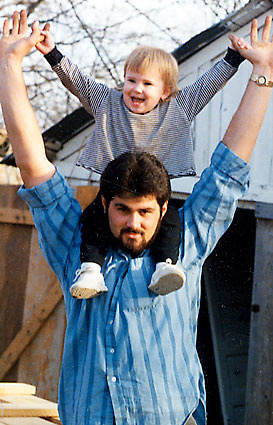Take a long look at the picture:
That's Amber Willingham and her father, Cameron Todd Willingham.
In 1992,the Willingham house caught fire. Amber and her two sisters perished.
Cameron, the father, was charged with murder. He is the only person in history charged with murder where fire was the weapon.
There wasn't much evidence against him. He was convicted largely on the testimony of Texas arson "experts" who claimed that there were twenty indicators of arson.
By 2004, Willington has exhausted his appeals. Much progress had been made in arson investigation techniques, and many (if not all) of the techniques used by the arson experts at Willingham's trial had fallen into disrepute.
For example, "crazed glass" — cracked but not shattered glass – was once thought to be an indicator of the use of a liquid accelerant. But "crazed glass" is now classified by fire investigation experts as an "Old Wives Tale." Crazed glass can be caused by a liquid accellerant, it can also be caused by the rapid chilling of hot glass by water used to extinguish a fire.
"Crazed glass" was only one of the indicators used to convict Willingham, but the other so-called indicators are largely myth-based.
Despite that fact the myths of his alleged arson were well-known by 2004, Cameron Todd Willingham was executed by the state of Texas on February 17, 2004. His last words included:
Yeah. The only statement I want to make is that I am an innocent man – convicted of a crime I did not commit. I have been persecuted for 12 years for something I did not do.
The story doesn't end there. Following some high-profile forensic screw-ups, the Texas Legislature in 2005 created a commission to investigate lab error, negligence, and misconduct among forensic experts.
Their first major review was the Willingham case. The commission hired an outside firm to review the case materials and issue a report. Their investigator, Craig Beyler, just released his findings, and his report is bonechillingly frank:
In a withering critique, a nationally known fire scientist has told a state commission on forensics that Texas fire investigators had no basis to rule a deadly house fire was an arson — a finding that led to the murder conviction and execution of Cameron Todd Willingham.
***
Among Beyler's key findings: that investigators failed to examine all of the electrical outlets and appliances in the Willinghams' house in the small Texas town of Corsicana, did not consider other potential causes for the fire, came to conclusions that contradicted witnesses at the scene, and wrongly concluded Willingham's injuries could not have been caused as he said they were.
The state fire marshal on the case, Beyler concluded in his report, had "limited understanding" of fire science. The fire marshal "seems to be wholly without any realistic understanding of fires and how fire injuries are created," he wrote.
The marshal's findings, he added, "are nothing more than a collection of personal beliefs that have nothing to do with science-based fire investigation."
Way to go, Texas.


